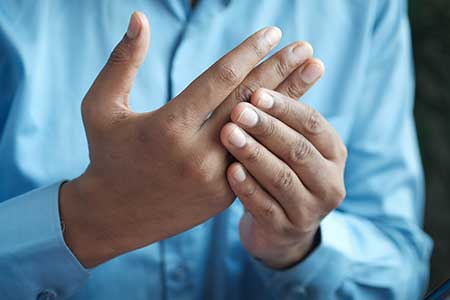ARTHRITIS

Arthritis and related diseases can cause debilitating, life-changing pain. According to the Centers for Disease Control and Prevention, more than one-third of the adults who have arthritis report that it limits their leisure activities and work. And 25 percent of them say it causes severe pain (seven or higher on a zero to 10 point scale). There are more than 100 different forms of arthritis and related diseases. The most common types include osteoarthritis (OA), rheumatoid arthritis (RA), psoriatic arthritis (PsA), fibromyalgia and gout. All of them cause pain in different ways.
Osteoarthritis
In osteoarthritis (OA), the protective cartilage inside the joint breaks down. This makes movement of affected joints more difficult and painful. In time, bones of the joint may rub directly against one another, causing severe pain. Pain can also come from parts of your joint other than the cartilage, such as bone, synovium and ligaments. The intensity of OA pain varies from person to person and can range from mild to severe.
Rheumatoid Arthritis
In rheumatoid arthritis (RA), the joints and other organs are attacked by the body’s own immune system. The immune system normally protects a person from viruses, bacteria and other invaders. In people with autoimmune diseases like RA, it becomes overactive and attacks healthy tissue. In the case of RA, the immune system primarily goes after the lining of the joints, called the synovium. Over time, the persistent inflammation breaks down the joint and damages it permanently.Pain in RA can come from other parts of your joint besides the synovium, such as bone and ligaments.
Psoriatic Arthritis
Psoriatic arthritis (PsA) is an autoimmune inflammatory disease in which the immune system attacks the body, causing inflammation and pain. PsA affects the joints, causing arthritis; the connective tissue where tendons or ligaments attach to bones, causing enthesitis; and the skin, causing psoriasis.
Fibromyalgia
Fibromyalgia is considered a central pain syndrome. This means that the brain and spinal cord process pain signals differently. A touch or movement that doesn’t cause pain for others may feel painful to you (this is called allodynia). Something that is mildly painful to someone without fibromyalgia may hurt you even more (this is called hyperalgesia).Fibromyalgia is characterized by widespread pain. It may come and go or be constant. Besides pain, fibromyalgia is associated with other symptoms, such as fatigue, sleep problems, inability to concentrate and mood troubles.
Gout
Gout is a form of inflammatory arthritis, but it does not cause body-wide inflammation like RA or PsA does. In gout, uric acid crystals are the problem. If your body produces too much uric acid or if you are unable to remove the excess fast enough, it can build up in the blood (called hyperuricemia). Excess uric acid can form crystals in your joints. This results in extremely painful joint inflammation. Gout usually strikes in the large joint of the big toe, but can also affect other joints. With a gout flare, you can go to bed feeling fine and wake up with excruciating pain.
Lupus
Lupus is an autoimmune inflammatory disease that affects many parts of the body, including the joints, kidneys, skin, blood, brain and other organs. It can cause joint pain, fatigue, hair loss, sensitivity to light, fever, rash and kidney problems.
Back Pain
Back pain can be a symptom of several forms of arthritis and related conditions, including ankylosing spondylitis, psoriatic arthritis and fibromyalgia. Most back pain, however, is the result of some type of injury, such lifting or bending improperly, a sports injury or an automobile accident.
Other Musculoskeletal Pain
Soft-tissue rheumatic conditions can also cause pain. In these conditions, muscles, connective tissues such as tendons and ligaments, and bursae become inflamed and painful.
